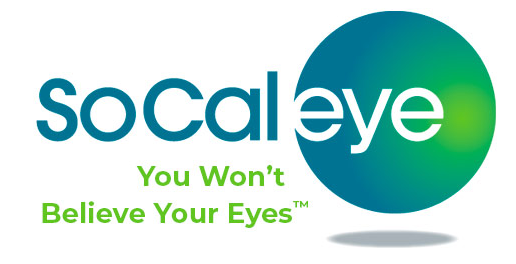
Early Stage Cataract Treatment:
Cataract Treatment is based on the level of vision loss being experienced. In the early stages of development where vision impairment is minimal no treatment may be needed. Patients are advised to follow a regular eye exam schedule and look out for any signs of change in vision acuity. As changes are detected a new eyeglass prescription may provide temporary vision improvement and anti-glare coatings on eyeglass lenses can help reduce glare for night driving.
Cataract Surgery:
Cataract Surgery is finally considered when the cataract progresses and a person’s ability to perform common daily tasks becomes impaired. Cataract surgery involves removing the lens of the eye and replacing it with an artificial lens (IOL). The artificial lens is implanted during a short surgical procedure and requires no further care. Cataract Surgery can reverse any vision loss associated with the cataract instantly.
At SoCal Eye we offer a no-stitch, no-patch, no-shot cataract removal procedure that only takes minutes to perform in the comfort of our private surgery center in Lakewood. Unlike cataract surgery of the past, modern cataract surgery that is performed here at SoCal Eye has a fast recovery time and most patients can see well the very next day.
What Happens During Cataract Surgery?
Cataract surgery, usually an outpatient procedure, takes an hour or less to perform from prep to completion. Cataract surgery is performed on one eye at a time.
First, the Cataract Surgeon will place eyedrops in the patient’s eye to dilate the pupil. Local anesthetic is administered to numb the area, and patients may be given a sedative to help them relax.
During cataract surgery, the clouded lens is removed, and a clear artificial lens is implanted. Phacoemulsification is the most common form of Cataract Surgery. The procedure involves the Cataract Surgeon using a laser to make a small incision in the side of the cornea (the clear outer covering of the eye) and inserting a very thin probe into the lens substance where the cataract has formed. The probe transmits ultrasound waves, to break up (emulsify) the cataract and suction out the fragments. The very back of the lens (the lens capsule) is left intact to serve as a place for the artificial lens to rest.
A clear plastic, artificial lens replaces the cloudy natural lens comprising the cataract and is implanted into the empty lens capsule. The replacement lens is called an intraocular lens (IOL). A number of options exist for selecting a replacement IOL and a SoCal Eye Cataract Specialist will be sure to help you make an informed and educated selection.
![]() See Choosing the Best Implants
See Choosing the Best Implants
What Happens After Cataract Surgery?
After cataract surgery, the patient should expect their vision to begin improving within a few days. Vision may be blurry at first as the eye heals and adjusts. Colors will immediately seem brighter after the surgery as cataracts usually mute the look of colors with a yellow or brown tint.
Patients will have a follow-up appointment with their eye doctor a day or two after surgery and then again after a week and a month post-surgery.
It’s normal for patients to feel itching and mild discomfort for a couple of days after surgery and rubbing of eyes should be avoided.
SoCal Eye – Cataract Treatment Long Beach:
Cataract surgery is one of the safest and most effective types of surgery performed in the United States today. It takes about 10 minutes to complete and approximately 90% of cataract surgery patients report better vision following the surgery. All treatment begins with a Consultation with a SoCal Eye Cataract Specialist or Cataract Surgeon in Long Beach. Serving patients in Cypress, Cerritos and Garden Grove.
For Cataract Treatment in Long Beach, Schedule an Appointment today at (562) 531-2020 or send us an Online Consultation Request



